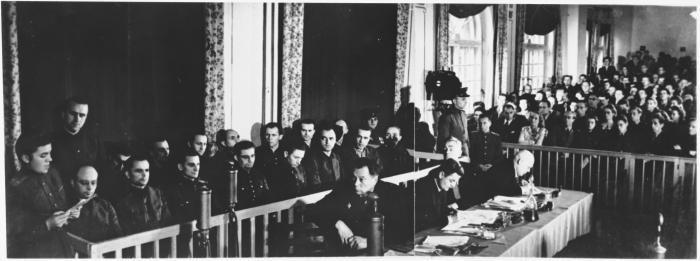
Sachsenhausen: Liberation and Postwar Trials
Between 1933 and 1945, Nazi Germany and its allies established more than 44,000 camps and other incarceration sites (including ghettos). The perpetrators used these locations for a range of purposes, including forced labor, detention of people deemed to be "enemies of the state," and mass murder. Millions of people suffered and died or were killed. Among these sites was the Sachsenhausen camp and its subcamps.
Liberation
SS camp guards began the forced evacuation on foot of 33,000 prisoners from the Sachsenhausen concentration camp to the northwest during the night of April 20–21, 1945.
The first groups to depart received minimal food rations; those who departed later received no food at all. On the march route, SS guards shot prisoners who were unable to keep up. The various groups marched out of Sachsenhausen became ever more disorganized as the Allied troops neared. As the marches continued, the structure of the group began to break up as guards began to flee and prisoners were able to separate from the group. In the two weeks following the start of the marches, US troops liberated surviving prisoners of the forced evacuations near the town of Schwerin, Germany. Soviet troops liberated surviving prisoners of those marched near Zechlin, Germany.
On April 22, units of the First and 47th Polish Armies, operating under overall Soviet command liberated about 3,000 remaining inmates in the camp. They found only about 3,000 ill and weak prisoners in the camp. Camp records indicate that the SS deported more than 140,000 prisoners to the Sachsenhausen concentration camp. Though a Soviet investigation commission estimated that over 100,000 prisoners died at Sachsenhausen, new research shows that a more realistic estimate is between 30,000 and 50,000 deaths. The SS also deported to Sachsenhausen tens of thousands of unregistered prisoners. The SS authorities interned an estimated number of 200,000 prisoners in Sachsenhausen during the camp's operation.
Postwar Trials
A Soviet investigation commission convened at Sachsenhausen after the war to collect evidence of SS crimes committed there. The commission's work led to the trial of 16 former camp functionaries before a Soviet military tribunal in Berlin in late October 1947. Those accused included the last camp commandant, Anton Kaindl, 12 other SS officers, a civil servant and two prisoner functionaries. In November 1947, the Soviet military tribunal convicted all the defendants. The tribunal sentenced 14 of the defendants to life in prison (the Soviet Union abolished capital punishment in May 1947). Two of the defendants received 15-year prison terms.
Critical Thinking Questions
- To what degree was the local population aware of this camp, its purpose, and the conditions within? How would you begin to research this question?
- Where were camps located?
- Did the outside world have any knowledge about these camps? If so, what, if any, actions were taken by other governments and their officials?
- What choices do countries have to prevent, mediate, or end the mistreatment of imprisoned civilians in other nations?

